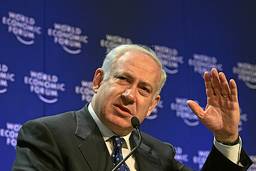Israel’s Center Does Not Hold
Netanyahu’s coalition begins to govern, as the world awaits a two-state solution.
Ralph Seliger

With Israel’s left splintered and shattered, Tzipi Livni’s centrist Kadima is now the main opposition to the hard right.
In Israel’s national election in February 2009, Livni garnered more votes and parliamentary seats than Benjamin Netanyahu, her main opponent and head of a resurgent Likud party. However, as is always true in Israeli elections, since no single party won a majority of seats in the Knesset, the candidates had to bargain with leaders of other parties to assemble a ruling coalition.
Netanyahu, the second place finisher with 27 Likud Knesset seats to Kadima’s 28, took office as prime minister because he was better able to cobble together a majority coalition from among the 12 party lists elected to parliament. Still, neither of the two largest vote getters won even a quarter of the popular vote.
Labor and Meretz, the two parties associated with (and blamed for) the Oslo Accords, were punished further, with Labor dropping from 19 to 13 seats and Meretz to three – only a quarter of their respective strengths when Rabin was elected on a peace platform in 1992. Labor has fallen from second place to fourth, behind Yisrael Beitenu (“Israel Our Home”), a surging party of the populist right led by Avigdor Lieberman, an immigrant from the former Soviet Union and a one-time aide to Netanyahu.
Both Labor and Lieberman’s party have chosen to join Netanyahu’s governing coalition, with Labor’s Ehud Barak resuming his job as defense minister and the notoriously undiplomatic Lieberman being appointed foreign minister. Barak is widely regarded as a competent minister of defense. Lieberman, known for such ill-tempered outbursts as telling Israel’s main Arab friend, Egypt’s President Mubarek, to “go to Hell,” seems problematic as foreign minister. (Under police investigation for money laundering and other possible charges, Lieberman may not last long.)
Yisrael Beitenu won 15 seats running an overtly anti-Arab campaign, reacting to pro-Hamas slogans of Israeli Arabs protesting the Gaza war. Lieberman advocates compulsory loyalty oaths and alternative national service for Arab citizens of Israel (other than the Druze, Arab Israelis are exempt from military conscription) and threatens them with a loss of citizenship for refusing to comply, though this is not part of his coalition agreement with Netanyahu.
These election results continue dramatic changes in Israel’s political landscape, changes that began with the second intifada in late 2000, which violently reversed the Oslo peace process of the 1990s. First, Ariel Sharon and his right-wing Likud party returned to power in landslide elections in 2001 and 2003. Then, in 2005, Sharon mobilized 50,000 soldiers and police to forcibly remove 8,000 settlers from the Gaza Strip. Sharon soon bolted from Likud and allied himself with Shimon Peres and other Laborites in a new party of the center, Kadima (“forward”).
Sharon’s successor, Ehud Olmert, moved rhetorically far beyond Sharon, pronouncing himself eager to negotiate a two-state solution. Following the framework agreed upon at Annapolis in November 2007, Olmert and his foreign minister, Tzipi Livni, met on a regular basis with leaders of the Palestinian Authority, but without concrete results.
Avigdor Lieberman’s rabble-rousing theatrics fit the current mood of much of Israel’s electorate, which has largely lost confidence in a negotiated peace with the Palestinians. Israelis overwhelmingly supported the recent military action against Hamas, but many were puzzled and disappointed that the army had not continued its offensive until rocket and mortar fire on southern Israel were completely stopped.
Theoretically, Lieberman is to the “left” of Netanyahu in having endorsed the concept of a Palestinian state, even declaring a willingness to leave his home in a West Bank settlement as part of a trade of territories to implement a peace agreement. In a typically hard-edged twist, however, Lieberman proposes that a heavily Arab part of Israel near the West Bank be transferred to the Palestinian state in exchange for Israel annexing the most populated settlement blocs contiguous to Israel proper. Now, as foreign minister, he’s renounced negotiations stemming from the November 2007 agreement between Israel and the Palestinian Authority in Annapolis.
In the meantime, Netanyahu, in his coalition deal with Labor, recognizes all existing agreements with the Palestinians, contradicting his party’s platform, which explicitly opposes a Palestinian state. But Netanyahu is known for contradictions and double-dealing. (In this case, it may be a good thing.)
Israel – as with so much of the world – awaits Obama’s intervention to somehow realize a peaceful two-state solution. Promising frameworks or models include the “Clinton Parameters” of late 2000, the unofficial Geneva Accord of December 2003, and the Saudi/Arab League peace initiative still on the table from 2002.
Concretely, Israel’s unilateral expansion of settlements in the West Bank and East Jerusalem needs to stop, and Hamas needs either to be co-opted into, or isolated from, a renewed initiative for peace. It’s an open question as to whether the Obama administration has the skill and the fortitude to make these things happen.









